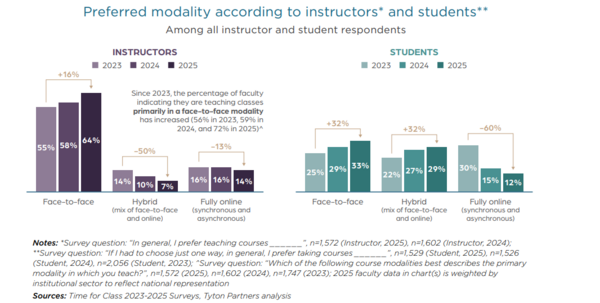A latest research from Tyton Companions finds that whereas massive numbers of upper training stakeholders are partaking with generative AI instruments, they nonetheless present a powerful choice for in-person instruction, human-led help and skills-based studying over different developments.
“It’s re-norming,” mentioned Catherine Shaw, managing director of Tyton Companions. “Individuals are determining alter to this innovation that helps all of the stakeholders within the ecosystem. [Generative AI] will be helpful to learners, it may be helpful to college and it may be helpful to answer suppliers.”
“Time for Class,” Tyton’s annual report on digital instruments and scholar success, evaluated survey responses from college students, directors and school members over the previous three years concerning generative AI and different improvements in larger training.
This yr’s report highlighted the worth of in-person studying and face-to-face engagement for scholar success, in addition to the methods school and workers can leverage tech instruments to boost the scholar expertise.
Methodology
“Time for Class” is a longitudinal research of digital studying in U.S. larger training. This yr’s survey was carried out in spring 2025 and contains responses from 1,500 college students, greater than 1,500 instructors and over 300 directors. The scholars surveyed attend two- and four-year schools and embody working college students, parenting college students and dually enrolled highschool college students.
Along with asking about generative AI use, the survey collected knowledge about digital courseware, ebooks and inclusive entry, in addition to modifications to digital accessibility compliance necessities.
Getting a grip on AI: The rise of generative synthetic intelligence instruments has soured college students’ and school members’ views of training, with every group accusing the opposite of utilizing AI to cheat. Despite a rising market for digital instruments and AI-assisted alternate options, the research discovered that each college students and instructors desire to have interaction in individual and with different people.
Slightly below two-thirds of college and one-third of scholars surveyed indicated that face-to-face programs have been their most popular technique of instructing and studying, respectively. In comparison with 2023 knowledge, 16 % extra instructors indicated they like face-to-face instructing, and 32 % extra college students mentioned they wished to study in individual.
On the similar time, choice for totally on-line programs fell amongst school from 16 % in 2023 to 14 % in 2025; for college kids it dropped from 30 % in 2023 to 12 % in 2025.

Tyton Companions
College students have been additionally much less probably than a yr in the past to say they primarily flip to generative AI instruments for assist after they’re struggling in a course. A majority (84 %) mentioned they flip to individuals after they need assistance, whereas 17 % mentioned they use AI instruments—a 13-percentage-point lower from spring 2024 respondents.
Researchers theorize this can be because of the issue college students expertise in prompting AI instruments to assist clarify classroom ideas.
“Understanding ideas, AI may not be the perfect for,” Shaw mentioned. “Getting solutions? AI would possibly give you the option that can assist you with that. There’s a fairly hanging distinction there, and I believe our learners are exhibiting us they’re beginning to perceive that.”
About one in three school members assume college students are turning to AI instruments for help. Twenty-nine % of instructors suppose college students prioritize assist from generative AI, whereas 86 % say they flip to individuals for assist. Roughly two-thirds of scholars say they use a stand-alone generative AI device like ChatGPT, and 30 % say they use embedded courseware instruments that incorporate generative AI.
Instructors nonetheless lag in common use of AI, with 30 % of professors saying they use generative AI instruments not less than weekly, in comparison with 42 % of scholars and 40 % of directors.
The elevated entry to generative AI instruments has not alleviated school workloads; half of college respondents mentioned their workload has seen no change and 38 % indicated AI is definitely creating extra work for them. The extra work contains monitoring dishonest (71 %) and creating assessments to counter scholar AI utilization (61 %). The one exception was amongst school who mentioned they use generative AI instruments very often or day by day: One-third of these respondents mentioned their workload has decreased.
Instantly after the launch of ChatGPT, school and directors at many establishments hurried to create insurance policies about scholar use of generative AI and educational dishonesty. A Could 2024 survey by Inside Larger Ed discovered that 31 % of college students mentioned they weren’t clear on after they’re permitted to make use of generative AI within the classroom. As of spring 2025, solely 28 % of establishments had a proper coverage on AI, whereas 32 % mentioned they’re nonetheless creating a coverage, in accordance with Tyton’s report.
“Establishments are maybe hesitant to set a central coverage, as a result of there’s so some ways this could possibly be used to a scholar’s benefit and drawback, depending on the sphere of research and the particular class, even,” Shaw mentioned. “You need your steerage to be sturdy sufficient to be understood by everybody, but additionally with sufficient leeway that people can be at liberty and have company to change because it is sensible for them.”
Whereas solely 4 % of directors agreed that scholar literacy of generative AI is measured as a studying end result at their establishment presently, 39 % indicated it will likely be within the subsequent three years.
The human factor: Regardless of college students’ reported curiosity in working with others, the school surveyed indicated that scholar engagement is low and educational dishonesty is on the rise.
Amongst instructors who educate introductory or developmental programs, 45 % mentioned their main classroom problem is stopping college students from dishonest. A further 44 % mentioned scholar attendance was their biggest concern.
When requested what hinders college students’ success within the classroom, 70 % of instructors mentioned they’ve ineffective research abilities and 47 % mentioned they lack stipulations for his or her course. School additionally noticed college students’ private challenges, akin to feeling anxious or overwhelmed (48 %) or missing motivation (38 %), as limitations to their success. Many college students agreed with their professors’ evaluation; 32 % of first-year college students and 28 % of constant college students mentioned they lack motivation within the classroom.
The shortage of motivation could possibly be tied to an absence of profession connections of their lecturers, notably for college kids in introductory or normal training programs, Shaw mentioned. However this problem may additionally inspire college students to get within the classroom and have interaction with others in order that they don’t need to battle alone, she added.
“Maybe the explanation some college students need extra face-to-face interplay with their friends or with their teacher, it’s that feeling … of frustration or a insecurity … It’s simpler when you find yourself in individual and you’ll see somebody struggling,” Shaw mentioned.
Tyton’s survey requested school to rank several types of knowledge they need that they had of their classroom to enhance scholar outcomes, and the highest response was “sentiment knowledge” on college students’ degree of frustration or confidence (35 %), adopted by visibility into college students’ grades in different programs throughout the time period (23 %). To Shaw, these responses recommend school are concerned with seeing their college students as entire individuals to allow them to higher help them.
Looking for tales from campus leaders, school members and workers for our Scholar Success focus. Share right here.



